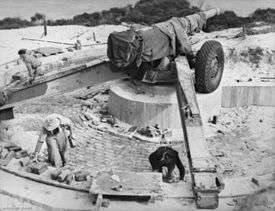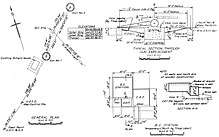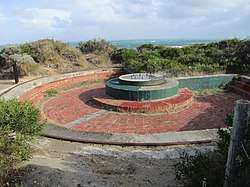Panama mount
The term Panama Mount describes a gun mount developed by the U.S. Army in Panama during the 1920s for fixed coastal artillery positions. Panama mounts were widely used during the buildup to and during World War II by the United States military.[1]

The mounts could be constructed as either full, 3/4 or half circles of steel rail set in concrete with a diameter of approximately 36 feet (11 m). A concrete column with a diameter of ten feet (3.0 m) was constructed in the center of the circle to support the gun and carriage. The concrete column was connected to the outer concrete ring by concrete beams for alignment/stability. Originally traverse was accomplished with several men and prybars to move the trailing arms around the steel ring. Later installations included a geared steel ring just inside of the outer steel rail for improved traverse. The Canon de 155mm GPF, designated 155 mm gun M1917 (French-made) or M1918 (US-made) in U.S. service, was often married with Panama mounts; these were the primary weapons of the United States Army Coast Artillery Corps' tractor-drawn mobile units 1920-1945.
In World War II, Panama mounts were used to rearm six Harbor Defense Commands that had been disarmed in the 1920s, and were used to augment existing and new harbor defenses in the US and overseas. They were used for new defenses in Alaska, Newfoundland, Puerto Rico, and Australia.[2]
The term Panama mount is often incorrectly used to describe other gun mounts with similar layouts and/or purpose.
Many surviving examples of these mounts can be found throughout former US coast defense sites including California, Florida, Alaska, and Panama.
 Recent photo of an abandoned Panama mount at Fort MacArthur
Recent photo of an abandoned Panama mount at Fort MacArthur Panama mount in Western Australia showing center concrete column and concrete beams
Panama mount in Western Australia showing center concrete column and concrete beams Panama mount at Battery 22, Former Fort Miles, now Cape Henlopen State Park, Delaware, with park's beach house in background
Panama mount at Battery 22, Former Fort Miles, now Cape Henlopen State Park, Delaware, with park's beach house in background typical plan for Panama mount
typical plan for Panama mount Restored Panama mount of the Peron Battery
Restored Panama mount of the Peron Battery
See also
- Barbette mount
- Disappearing carriage
- Seacoast defense in the United States
- List of U.S. Army weapons by supply catalog designation
References
- Berhow, pp. 200-223
- Berhow, pp. 200-223
- Berhow, Mark A., Ed. (2004). American Seacoast Defenses, A Reference Guide, Second Edition. CDSG Press. ISBN 0-9748167-0-1.
- List of all US coastal forts and batteries at the Coast Defense Study Group, Inc. website